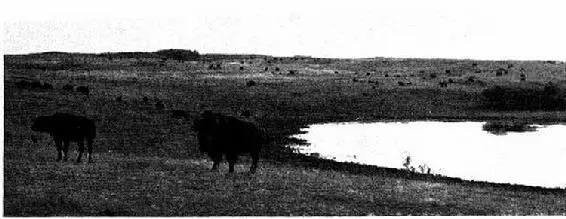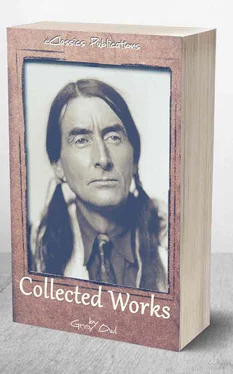Grey Owl (Archibald Stansfeld Belaney) - The Collected Works of Grey Owl
Здесь есть возможность читать онлайн «Grey Owl (Archibald Stansfeld Belaney) - The Collected Works of Grey Owl» — ознакомительный отрывок электронной книги совершенно бесплатно, а после прочтения отрывка купить полную версию. В некоторых случаях можно слушать аудио, скачать через торрент в формате fb2 и присутствует краткое содержание. Жанр: unrecognised, на английском языке. Описание произведения, (предисловие) а так же отзывы посетителей доступны на портале библиотеки ЛибКат.
- Название:The Collected Works of Grey Owl
- Автор:
- Жанр:
- Год:неизвестен
- ISBN:нет данных
- Рейтинг книги:4 / 5. Голосов: 1
-
Избранное:Добавить в избранное
- Отзывы:
-
Ваша оценка:
- 80
- 1
- 2
- 3
- 4
- 5
The Collected Works of Grey Owl: краткое содержание, описание и аннотация
Предлагаем к чтению аннотацию, описание, краткое содержание или предисловие (зависит от того, что написал сам автор книги «The Collected Works of Grey Owl»). Если вы не нашли необходимую информацию о книге — напишите в комментариях, мы постараемся отыскать её.
"The Collected Works of Grey Owl"
Description:
"The Collected Works of Grey Owl" comprises the works of Grey Owl, or Wa-sha-quon-asin, the Indian name of English-born Archibald Stansfeld Belaney (September 18, 1888 – April 13, 1938), chosen by himself when he took on a First Nations identity as an adult. This collection consists of his three books «The Men of the Last Frontier», «Pilgrims of the Wild» and «The Adventures of Sajo and her Beaver People», all in one volume.
The Collected Works of Grey Owl — читать онлайн ознакомительный отрывок
Ниже представлен текст книги, разбитый по страницам. Система сохранения места последней прочитанной страницы, позволяет с удобством читать онлайн бесплатно книгу «The Collected Works of Grey Owl», без необходимости каждый раз заново искать на чём Вы остановились. Поставьте закладку, и сможете в любой момент перейти на страницу, на которой закончили чтение.
Интервал:
Закладка:
Not so spectacular, this still-hunt, as were the great buffalo hunts of the emigrant trains crossing the plains, half a century ago, but every bit as much a part of the history of the development of the continent. As on to-day's frontier, the settler then was not as expert as his neighbour, the Indian, but by hook or by crook, he got his meat, and so does his successor to-day. An old-time buffalo hunt was an inspiring sight. The strings of light-riding savages on their painted ponies, probably the best irregular light mounted infantry the world has ever seen, naked to the waist, vieing with each other in spectacular and hazardous stunts, exhibiting a skill in horsemanship never attained to by trained cavalry; the black sea of rolling humps, and bobbing heads, the billowing clouds of dust through which the fringe of wild, yelling horsemen were intermittently visible; the rumbling of innumerable hoofs, and, in the case of white men, the thudding of the heavy buffalo guns, combined to produce a volume of barbaric uproar, and a spectacle of wild confusion and savagery that had its duplicate in no part of the world.

Stragglers from the main herd dot the prairie, haunted by the
great gaunt spectres of the wild lands, Lobo, the buffalo wolves.
The Indian and the settler killed, generally speaking, only enough for their needs. Then buffalo hides became of value, a dollar a piece or less. Immediately every man with the price of a camp outfit, a couple of wagons, a few horses and a gun, took to the buffalo country and, under pretence of clearing the plains for agricultural purposes, these animals were slaughtered without mercy. Right-minded people arose and condemned the perpetration of such a heinous crime as the destruction of an entire species to satisfy the greed of a few men. The United States Government, however, took no steps to prevent it, one official even suggesting placing a bounty on the buffalo, as it was understood that their destruction would settle once and for all the vexing and ever-present Indian problem.
It is worthy of note that at this time, Canada, with a large Indian population, had no such problem. The Blackfeet domiciled on both sides of the international boundary, whilst raiding trapper camps and committing depredations on the American side, respected the peace treaty they had made with Canada. This proves conclusively that a little tact and consideration could have accomplished with the Indians what bodies of armed troops could not.
Although no bounties were actually offered, the policy of destruction was carried out to the letter. The Indians, friendly or otherwise, took the war-path in defence of their ancient birthright; retaliatory tactics of the utmost cruelty were carried out against them, and some tribes were wiped almost out of existence. For several years, not many, the prairie became a shambles. The buffalo were eventually coralled in the state of Texas on one of their annual migrations, and one spring they failed to appear on the Canadian plains. The Indian problem was settled for all time.
A whole species of a useful and noble animal had been destroyed, and an entire race of intelligent and courageous people decimated and brought into subjection, in the space of a number of years that could be counted on the fingers of a man's two hands.
Allowing at a conservative estimate two hundred pounds of meat to each beast, and considering the semi-official computation of their number, which was around ten million head, it can easily be computed that two hundred million pounds of first-class meat, excepting the little that could have been eaten by the hunters themselves, was allowed to rot on the prairie. Add to this the greed and cruelty of the act, and the pitiable spectacle of the thousands of calves dying of neglect, or becoming a prey to wolves. This, however, is not the kind of Empire-building of which I like to speak, and serves as a very poor example of my subject. This hecatomb, too, was hardly a still-hunt.
It is not given to all to acquire skill in this most thrilling of sports. He who would become proficient at it must learn to move as a shadow, his actions smooth as oil, and his senses set to a hair-trigger touch; for the forest is argus-eyed, and of an unsleeping vigilance, and must always see him first.
Still-hunting is an art learned from the Indian, an accomplishment in which few white men excel, save only those who have spent many days in the lodges of those silent, thoughtful people, or consorted much with those who have. I can almost hear the howl of protest going up from a host of pseudo-bushmen, whose experience is confined to running moose down in deep snow, blundering on them in sections where they are numerous, or shooting them at the water's edge, which anybody can do. I repeat that the average white man is not a good still-hunter.
There are exceptions; famous guides, celebrated for their skill in "calling," crafty as the savage whose tricks they have acquired, men who have earned a reputation of never coming out without their moose, are to be met in bush communities in all parts of Canada; but they are as outstanding there as is a genius in a colony of artists. But all must take off their hats to the Indian. His own evasive, subtle mind fits him admirably to cope with the cunning and elusive nature of such animals as moose and deer. Indeed, it is probable that his type of mentality has been evolved by just such exercises during many generations, for the red man is primarily a hunter. Few but he are able, without snow, and in most cases even with it, to track and locate a moose without scaring the animal (in which case he is gone, and as impossible to overtake as a train would be), for no moose, unless bogged to the shoulders in snow, has ever been taken by tracking him down from behind. Not all are mentally fitted to enter into the intricacies of move and countermove, advance, circle, and retreat which must be studied in each case, or to guess the necessary allowance for the changing of a scarcely perceptible breath of wind.
Busy workers have not the time to acquire the knowledge that warns of too close an approach to a disadvantageous firing position, nor have they, unless they live as close to Nature as their swarthy brethren, the instinct that evinces itself in the culminating achievement of knowing the exact position of the moose in relation to himself, before the last two or three steps are to be made that will expose the hunter, and give him his shot at a quarry that he has stalked for an hour. And all this without sight, sound, or indication of the presence of moose, excepting perhaps some week-old tracks and nibbled branches, and in a section, such as moose commonly resort to, where a man is lucky to be able to see ten feet ahead of him.
It takes no little skill also to enter a "yard" of moose, padded down with tracks as numerous as those of cows in a pasture, and make a specific set at one particular beast. Yet this is necessary; hit or miss, rambling tactics meeting with no more success than firing into the centre of a flock of ducks ever does. The least carelessness of approach, the rattle of cartridges in the pocket, the slapping of a twig on the clothing, or even too much mental concentration on the animal itself, causing uneasiness, will alike result in a sudden flurry and crackling of twigs and brush, the measured, rapidly diminishing thump of hoofs driven by legs working like piston-rods, the distant crash as some rotten tree gives way before the driving weight of flesh, bone, and muscle, and then utter silence. And like as not without a hair of the quarry having been seen.
The actual shooting is child's play. More moose are killed at fifty feet by good hunters, than at a hundred yards by good shots. A moose is not a hard target, and once seen, looms up amongst the undergrowth like the side of a barn. The difficult part is to get to see him. On the still-hunt the sum and substance of the hunter's efforts are to see the animal before it sees him; to closely approach a moose without his being aware of your presence is an impossible feat, as indeed it is with any other of these dwellers amongst the leaves. But like all the other types of deer, unless rendered frantic by the scent of man, his curiosity gets the better of him; he will stay until he gets a fleeting glimpse of what he is running away from. That is the hunter's only chance of success.
Читать дальшеИнтервал:
Закладка:
Похожие книги на «The Collected Works of Grey Owl»
Представляем Вашему вниманию похожие книги на «The Collected Works of Grey Owl» списком для выбора. Мы отобрали схожую по названию и смыслу литературу в надежде предоставить читателям больше вариантов отыскать новые, интересные, ещё непрочитанные произведения.
Обсуждение, отзывы о книге «The Collected Works of Grey Owl» и просто собственные мнения читателей. Оставьте ваши комментарии, напишите, что Вы думаете о произведении, его смысле или главных героях. Укажите что конкретно понравилось, а что нет, и почему Вы так считаете.












